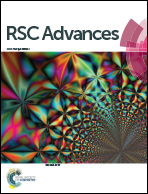Electrochemical performance of graphene-coated activated mesocarbon microbeads as a supercapacitor electrode
Abstract
Hybrid activated carbon/graphene materials are prospective candidates for use as high performance supercapacitor electrode materials, since they have the superior characteristics of high surface area, abundant micro/mesoporous structure due to the presence of activated carbon and good electrical conductivity as a result of the presence of graphene. In this work, the electrochemical performance of facile and low-cost graphene-coated activated mesocarbon microbeads (g-AM) is carefully studied. The results show that g-AM can only be formed at a very high temperature over a long activation time, resulting in the formation of a large pore size and low specific surface area, further resulting in poor electrochemical performance (110 F g−1 at 0.1 A g−1 in 6 M KOH solution). Ball milling for a short time is an effective way to improve the electrochemical performance (191 F g−1 at 0.1 A g−1 in 6 M KOH solution). Moreover, due to the strong resistance to aggregation and good electrical conductivity of graphene flowers, the g-AM had nearly 100% rate capability when increasing the current density from 5 to 50 A g−1. The as-assembled two-electrode symmetric supercapacitor exhibits a high energy and power density (5.28 W h kg−1 at 10 000 W kg−1) in organic LiPF6 electrolyte, due to its better electrical conductivity. It is expected that this type of hybrid structure holds great potential for scalable industrial manufacture as supercapacitor electrodes.



 Please wait while we load your content...
Please wait while we load your content...